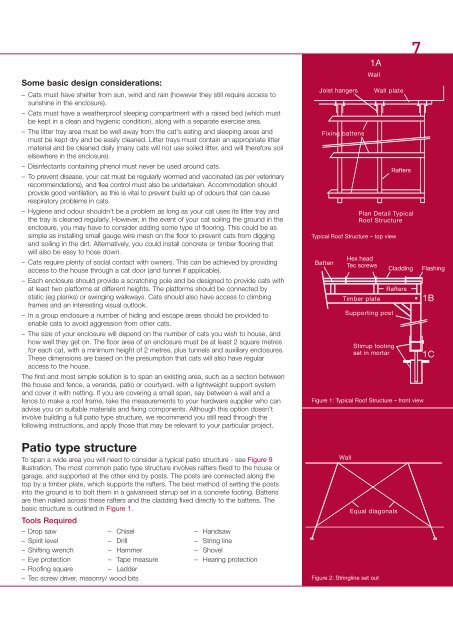How to build a cat enclosure - City of Tea Tree Gully
How to build a cat enclosure - City of Tea Tree Gully
How to build a cat enclosure - City of Tea Tree Gully
You also want an ePaper? Increase the reach of your titles
YUMPU automatically turns print PDFs into web optimized ePapers that Google loves.
Some basic design considerations:– Cats must have shelter from sun, wind and rain (however they still require access <strong>to</strong>sunshine in the <strong>enclosure</strong>).– Cats must have a weatherpro<strong>of</strong> sleeping compartment with a raised bed (which mustbe kept in a clean and hygienic condition), along with a separate exercise area.– The litter tray area must be well away from the <strong>cat</strong>'s eating and sleeping areas andmust be kept dry and be easily cleaned. Litter trays must contain an appropriate littermaterial and be cleaned daily (many <strong>cat</strong>s will not use soiled litter, and will therefore soilelsewhere in the <strong>enclosure</strong>).– Disinfectants containing phenol must never be used around <strong>cat</strong>s.– To prevent disease, your <strong>cat</strong> must be regularly wormed and vaccinated (as per veterinaryrecommendations), and flea control must also be undertaken. Accommodation shouldprovide good ventilation, as this is vital <strong>to</strong> prevent <strong>build</strong> up <strong>of</strong> odours that can causerespira<strong>to</strong>ry problems in <strong>cat</strong>s.– Hygiene and odour shouldn’t be a problem as long as your <strong>cat</strong> uses its litter tray andthe tray is cleaned regularly. <strong>How</strong>ever, in the event <strong>of</strong> your <strong>cat</strong> soiling the ground in the<strong>enclosure</strong>, you may have <strong>to</strong> consider adding some type <strong>of</strong> flooring. This could be assimple as installing small gauge wire mesh on the floor <strong>to</strong> prevent <strong>cat</strong>s from diggingand soiling in the dirt. Alternatively, you could install concrete or timber flooring thatwill also be easy <strong>to</strong> hose down.– Cats require plenty <strong>of</strong> social contact with owners. This can be achieved by providingaccess <strong>to</strong> the house through a <strong>cat</strong> door (and tunnel if applicable).– Each <strong>enclosure</strong> should provide a scratching pole and be designed <strong>to</strong> provide <strong>cat</strong>s withat least two platforms at different heights. The platforms should be connected bystatic (eg planks) or swinging walkways. Cats should also have access <strong>to</strong> climbingframes and an interesting visual outlook.– In a group <strong>enclosure</strong> a number <strong>of</strong> hiding and escape areas should be provided <strong>to</strong>enable <strong>cat</strong>s <strong>to</strong> avoid aggression from other <strong>cat</strong>s.– The size <strong>of</strong> your <strong>enclosure</strong> will depend on the number <strong>of</strong> <strong>cat</strong>s you wish <strong>to</strong> house, andhow well they get on. The floor area <strong>of</strong> an <strong>enclosure</strong> must be at least 2 square metresfor each <strong>cat</strong>, with a minimum height <strong>of</strong> 2 metres, plus tunnels and auxiliary <strong>enclosure</strong>s.These dimensions are based on the presumption that <strong>cat</strong>s will also have regularaccess <strong>to</strong> the house.The first and most simple solution is <strong>to</strong> span an existing area, such as a section betweenthe house and fence, a veranda, patio or courtyard, with a lightweight support systemand cover it with netting. If you are covering a small span, say between a wall and afence <strong>to</strong> make a ro<strong>of</strong> frame, take the measurements <strong>to</strong> your hardware supplier who canadvise you on suitable materials and fixing components. Although this option doesn'tinvolve <strong>build</strong>ing a full patio type structure, we recommend you still read through thefollowing instructions, and apply those that may be relevant <strong>to</strong> your particular project.Patio type structureTo span a wide area you will need <strong>to</strong> consider a typical patio structure - see Figure 9illustration. The most common patio type structure involves rafters fixed <strong>to</strong> the house orgarage, and supported at the other end by posts. The posts are connected along the<strong>to</strong>p by a timber plate, which supports the rafters. The best method <strong>of</strong> setting the postsin<strong>to</strong> the ground is <strong>to</strong> bolt them in a galvanised stirrup set in a concrete footing. Battensare then nailed across these rafters and the cladding fixed directly <strong>to</strong> the battens. Thebasic structure is outlined in Figure 1.Tools Required– Drop saw – Chisel – Handsaw– Spirit level – Drill – String line– Shifting wrench – Hammer – Shovel– Eye protection – Tape measure – Hearing protection– Ro<strong>of</strong>ing square – Ladder– Tec screw driver, masonry/ wood bitsJoist hangersJoist hangersFixing battensFixing battensBatten1AWall1AWallWall plateRaftersPlan Detail TypicalRo<strong>of</strong> StructurePlan Detail TypicalRo<strong>of</strong> StructureHex headTec screwsTimber plate7RaftersCladdingSupporting postRaftersTimber plateWall plateTypical Ro<strong>of</strong> Structure – <strong>to</strong>p viewBattenHex headTec screwsSupporting postStirrup footingset in mortarStirrup footingset in mortarRaftersCladdingFigure 1: Typical Ro<strong>of</strong> Structure – front viewWallEqual diagonalsFigure 2: Stringline set outFlashing1BFlashing1B1C1C

















